Here on the upper Sunshine Coast of BC, what is locally known as qathet, it seems that almost everybody knows about or has met my dogs. In total, there are 27(!) living here that are all connected to me in some way. This includes the collie mutt grandma named Sophie and the husky-malamute grandpa named Tiko; all but one of their five pups (i.e. Bella, Freya, Darcy, and Butch), and then the 21 puppies I’ve had since 2020. And, no, before anyone asks, I am not a breeder: I only ask enough to cover the cost of a biologically appropriate raw food diet (which you can read more about here, including what to feed your puppy).
The most recent, relevant part of the story begins with me coming back to qathet from teaching in Nepal in the spring of 2020, after being stranded in India at the outset of the pandemic because of Modi’s “Lakshman Rekha”. I had moved to qathet in 2019 and only started to connect with the local community before I left for Nepal to lead a five-week educational program in Ayurveda. When I finally got home safely in Canada, and then out of quarantine, there were few ways to connect with my local community. I did some things, for example, I participated in a Zoom-based rendition of It’s A Wonderful Life, playing the lead character of George. However, like most other “contact-less” methods of human interaction during the pandemic, it was about as satisfying as you might think.
Spending much of my time in the garden during the summer of 2020, I began to contemplate getting one of my dogs pregnant to continue the lineage I had started. I had discovered that matching parents based on temperament rather than breed yielded incredibly sweet and calm-natured animals, free of the common genetic disorders seen in purebreds. I found out that the local SPCA had no dogs to adopt, and because people were asking me about puppies, I decided to get not just one but both my dogs (sisters from the same litter) knocked up with the same sire, a sweet-natured malamute-husky cross named Tetso from Haida Gwaii. This meant — cue the banjo music — that all the pups would either be siblings, or half-siblings and also cousins. Lol, the social experiment had begun!
I then adopted these pups out to the local community, with the stipulation that they all remain living here in the qathet region. My intention especially during pandemic, was to use this opportunity to create community — for myself as a newcomer — but for anyone else that was looking for the same. A community of dog owners where all the dogs are related, bringing each owner into relationship within a larger family.
During 2020/21 we had some epic dog parties. At the first puppy reunion in January of 2021 there were 19 dogs frolicking in the snow on my little farm, while their humans stood around a fire, talking, laughing and drinking apple cider. In between the other gatherings, we had one amazing day at Sliammon lake where I remember balancing six dogs and another human on my paddle board. But apart from these events, what has been most heartening are the personal connections that owners have independently made with each other, and the ways in which they have been able to offer companionship and support to people they might not otherwise have not gotten to know. While it doesn’t mean that everyone hangs out with each other all the time, it allows for ease and familiarity in connection, that is rooted in the authenticity of feeling that dogs especially bring into our lives. All my doggy family tells me just how much they appreciate being part of this community, and of course, just how wonderful their dog is.
In many respects, for me personally, moving to qathet in 2019 was a kind of second chance, particularly after experiencing several years of what might be described as a living hell. Experiencing first or second-hand through close family pretty much every drama/trauma that each of us is likely to experience over a lifetime — disease, death, and destruction — over a 3–4-year period, I likened my arrival in qathet as a controlled crash. Perhaps that seems too dramatic a statement now, since I have been able to create a literal garden of opportunity from these charred roots, but it certainly felt like it at the time.
Having these two litters of 14 puppies and the opportunity to co-create community in particular provided me deep sense of renewal. I appreciated so much my relationship not just with the owners, but of course all the pups who never forgot who I was, or my home where they were born. The dog I kept, whom I named Cheno, was particularly cherished and a font of love and playfulness that kept my household vibrating at a high level. Here she is playing with my cat Mingus:
On May 8 of 2022, however, poor Cheno made a huge blunder and far from her pack, ran across a main road, jumping directly in front of a car and was killed, dying in my arms about eight minutes later. I was especially stricken with that special sense of guilt one has when you know that if you had done just one thing differently, a bad thing might never have happened. I cremated Cheno in my yard the next day, with several community members attending, which brought me a kind of closure that I wish all of us could have with our departed loved ones. The next day I gathered her ashes, buried them in a hole, and planted a black elderberry over top, which now carries her physical essence in its medicine.
For the next several weeks as I was wracked with sadness, my chief comfort were the two moms — Bella and Freya — who whenever they heard me sob or even let out a big sigh, would come running up to comfort me, not leaving me alone until the sadness had shifted. Despite this solace it was still particularly painful that as the nexus of this dog community, my primary connection to it had been severed. A sense of despair crept into my life. People often say “it’s meant to be” when things go well, but what about when disaster happens? Did I despite all my efforts to the contrary, somehow deserve this trauma, that I was “meant” to experience this sadness and loss? I spent a lot of time thinking about this, sitting with these feelings of pity and self-judgment, that maybe for whatever reason, I didn’t deserve happiness.
But I also couldn’t shake the idea that the universe had somehow made a massive mistake. Cheno was too well-loved, and the puppy community connections I created were just too special for it to fall apart in this way. I began to have a sense that I could call Cheno back from the bardo state, that I could somehow get the universe to admit to me that it does make mistakes, and that we might in some fashion, be able to repair them.
By late summer of 2022 Cheno’s mom Bella went into heat, and at seven years old, it was my very last opportunity to breed her. So even despite my feelings of trepidation, I decided to mate her again with Cheno’s dad and hope for the best. Just over two months later — yes, that’s how long it takes! — I had another litter of seven, healthy puppies, and another opportunity to expand my local community. And wouldn’t you know it, one of those pups had almost identical markings to Cheno! I can’t say she is the same dog — I don’t even really know what I believe when it comes to reincarnation vs rebirth and the metaphysical implications of each — but she sure seems similar to me.
I named Cheno when one day, as a yet-to-be-named puppy was chewing on a bone near my feet, I was learning some words in the Sliammon language, ʔayʔaǰuθəm (“ayajuthem”), spoken by the indigenous Tla’amin peoples whose land I live on. I was going through various words and happened upon the word “č̓ɛno” (“cheno, dog”), and repeated it several times out loud. The puppy stopped chewing on her bone, pricked up her ears and stared at me intensely. Then she barked and ran forward to touch my hand with her nose, looking up at me expectantly, before sauntering back to her bone. I figured that she clearly chosen her name, even if “dog” wasn’t the most imaginative. But born here on Tla’amin land, she somehow she seemed to embody the energy of the place, as the quintessential expression of the dog spirit, č̓ɛno.
Well, when the latest pups were about four weeks old, I was lying on kitchen floor with Cheno’s look-a-like in front of me, and I asked her, “is your name Cheno?” She stared intently into my eyes for a few more moments, barked twice, and then came up and booped me on the nose. Over the following weeks I had several other interactions with her that made me think of my late pup, and while I struggle very hard not to call her Cheno, I did eventually give her a new name — Mayalu — which in Nepali means “sweet heart.” And, I am happy to report, she is very deserving of her name.
This whole experience has made me think about the opportunity of second chances, what they are and how we can harness their power. Anyone that has loved and lost knows that love contains within it an infinite well of suffering and pain. Parents especially understand this fact. The more intensely we love the greater the potential to experience its opposite, postulating an unending drama of happiness and suffering. The pull of happiness and the push of suffering is a dynamic well-described among Hindus and Buddhists, as rāga (“desire”) and dviṣ (“aversion”), two interdependent factors that arise when existing within a state of spiritual “ignorance” (avidyā).
For those that seek to transcend the push and pull of this endless dynamic we are told to consider the path of prajñā (“knowledge”), which expressed into simple terms in Buddhism, refers to the cultivation of śīla (“morality/ethics”), śamatha (“peace”), and vipaśyanā (“mindfulness”). Even despite the simplicity of this equation, however, it’s very clear that this path fundamentally applies to someone fully engaged in a "desire-less" existence. As a so-called gṛhastha, or householder, it’s impossible for me to follow this path fully and still live “in-the-world”. Likewise, apart from the opportunity of detachment and “going forth”, this is not a path that acknowledges the importance of second chances.
Nonetheless, with my dog Mayalu, and increasingly in other areas of my life that I had thought become permanently quiescent, I find that I am being offered a number of second chances. Sometimes I reflect that it might just be some sort of inevitable stage I’m going through, but it’s hard to dismiss when I’m also very aware of my limited time here on earth, lending an unanticipated poignancy and beauty to these second chances.
I am learning quite a bit about these second chances, and about myself in the process. First off, a second chance has little to nothing to do with the first kick at the can. And this is the temptation that many fall into, bringing the baggage of their previous experience into the present. If something new is manifesting in your life, it is not just a continuation of the past. A second chance implies a fresh start, where fully conscious of our examined past, we can ensure that we do not repeat the same mistakes and patterns. A true second chance is a fresh start and a clean slate, and this opportunity requires a lot more work than just falling into whatever is new and different.
Perhaps most importantly, a second chance can’t arise until the first opportunity is dead. Whether it be a career, a relationship, or a different direction in life, a second chance does not begin until the first one ceases to be relevant. This can inevitably involve a lot of grief, as we essentially must say goodbye to a part of ourselves that we had so much invested in. Acknowledging and working through this grief is perhaps the most important part of cultivating a true second chance. A second chance, like the anticipation of spring before a cold, bitter winter, requires faith, openness, vulnerability, and above all, patience. And while there will always be illusions and misconceptions in this life, a second chance also allows us to become a little wiser and more thoughtful, fully cherishing the poignancy of each moment: fully cognizant that even second chances, too, will someday end.
As we emerge from almost three years of the pandemic and all its restrictions, the issue of second chances also applies more broadly to society. No matter what side of the debate you were on, we all suffered: not just from the threat of disease but from the various medical and social measures to prevent its spread. There was no easy way out of the pandemic, and if you made it through with your heart intact, you did the best job you could. Some of us sailed through the pandemic with minimal impact; others experienced devastating losses and huge inconveniences. Hopefully we all learned something, and now as we look forward to a fresh start, that we take some time to grieve and let go of all the emotional baggage that this crisis resulted in. While we cannot escape the past, and must contend with a seemingly unending stream of ongoing challenges, including war and financial instability, may the spirit of the season allow the energy of renewal to guide us all to a place of healing.
Doggie update!
It was early afternoon on Monday, February 27 when I was in my lab making some medicine, and opened the basement door to find my dog Bella leaning up against the door, completely paralyzed from the hips down, and her front legs in a state of rigid contraction. I lifted her up, brought her inside, and tried to ascertain a cause. While she objected to me putting her on her back, after thoroughly palpating and examining her body, there was no obvious area of pain or injury. I then rushed her to our local vet who was likewise baffled, suggesting it might be a seizure, until we did an x-ray and saw a narrowing between two of her vertebrae, suggesting a herniated/damaged disc. The current theory is that she probably injured herself jumping over the fence - something that she had been doing since fostering out her last litter, going on some “self-directed” wanders in my local neighborhood.
Poor Bella was in obvious distress. Normally an easy-going and vivacious dog, there was no other way to describe her mental state other than depressed. She was particularly distressed whenever I left the house, especially with the other dogs to take them for a walk. Adding to the complication was the fact that wasn’t able to urinate, leaving her bladder incredibly tense and full, with the otherwise remarkably healthy bloodwork showing an elevation in blood urea nitrogen (BUN). The only way to relieve the pressure and obvious discomfort was to load her up on a dose of diazepam and prazosin, and take her outside to physically squeeze her bladder to provide relief. Suffice it to say that it was an uncomfortable and challenging procedure for both of us!
Apart from this the vet didn’t have much to offer except an NSAID and suggested I rush her down to the Big City for a $10K surgery. Instead, I had him shave her back over the region of injury so I could apply medicines topically. For the first two days I applied the Chinese patent remedy Zheng Gu Shui, a liniment that I often use for acute sports injury. I alternated this with a cottonwood leaf bud oil (1:3 in olive oil), and then on day three, switched from the liniment to a Saint John’s Wort tincture (1:2) mixed with DMSO.
I applied these remedies more or less constantly for several days. Six days later I woke up to greet Bella, and for the first time I saw a tiny little wag of her tail — but just enough to give me some hope. Over the next 24 hours she then progressed remarkably quickly, and was finally able to relieve herself on her own. I continued to apply the remedies for another week, internally giving her SJW tincture, twice daily. About 10 days after the initial injury I walked her into the vet hospital to everyone’s amazement — lovely people who were so happy that Bella could walk — but all of them amazed that she was doing as well as she was without expensive surgery.
Now some three weeks later Bella has improved significantly. Although I am quite sure she will never be the same, her continued improvement amazes me. At seven years old, she’s had a pretty exciting life, with two litters and lots of adventures. Over the last week or so I let up on the topical treatments because my constant application did eventually create some local irritation, but I will likely shave the area again and continue with some more topical treatments. Internally, I have just started giving her two Ayurveda formulas I get from my colleagues in Nepal for acute/chronic musculoskeletal/nervous inflammation called Yogaraja guggulu and Kaishora guggulu. She’s not a huge fan, but the promise of a big dollop of butter after administration seems to be incentive enough to keep them down.




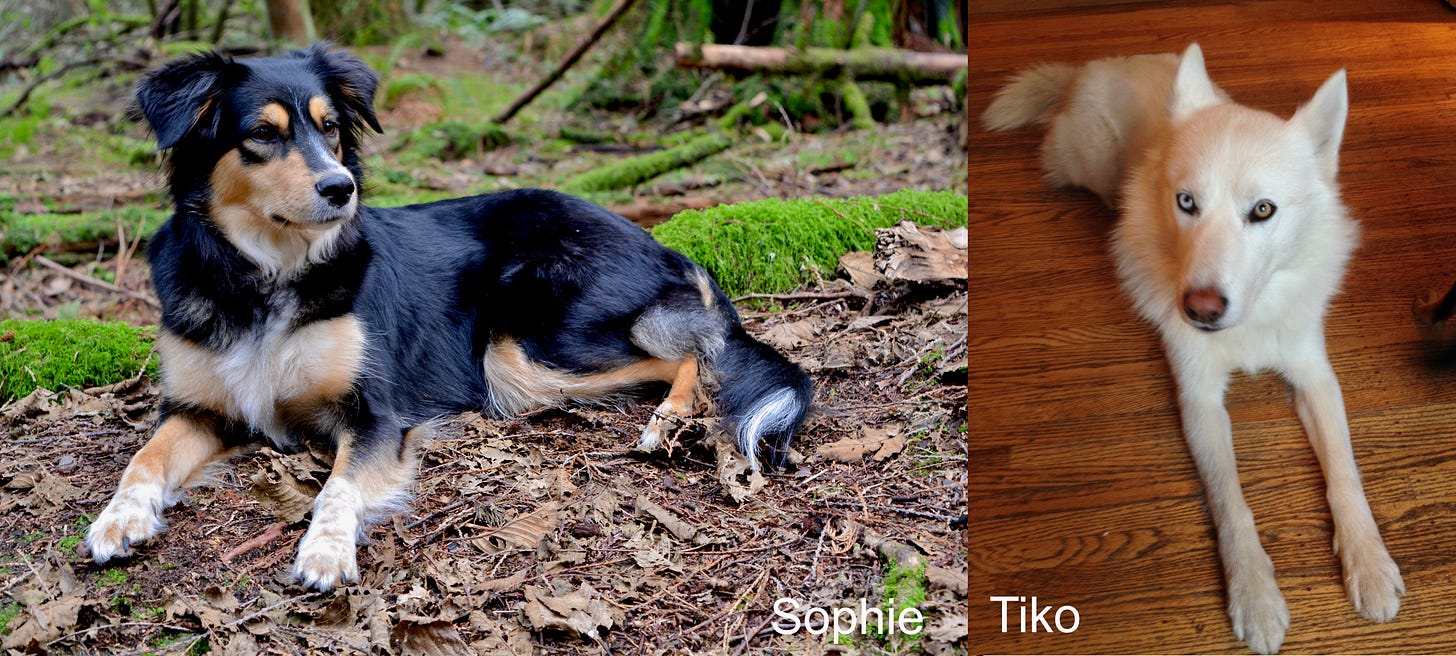
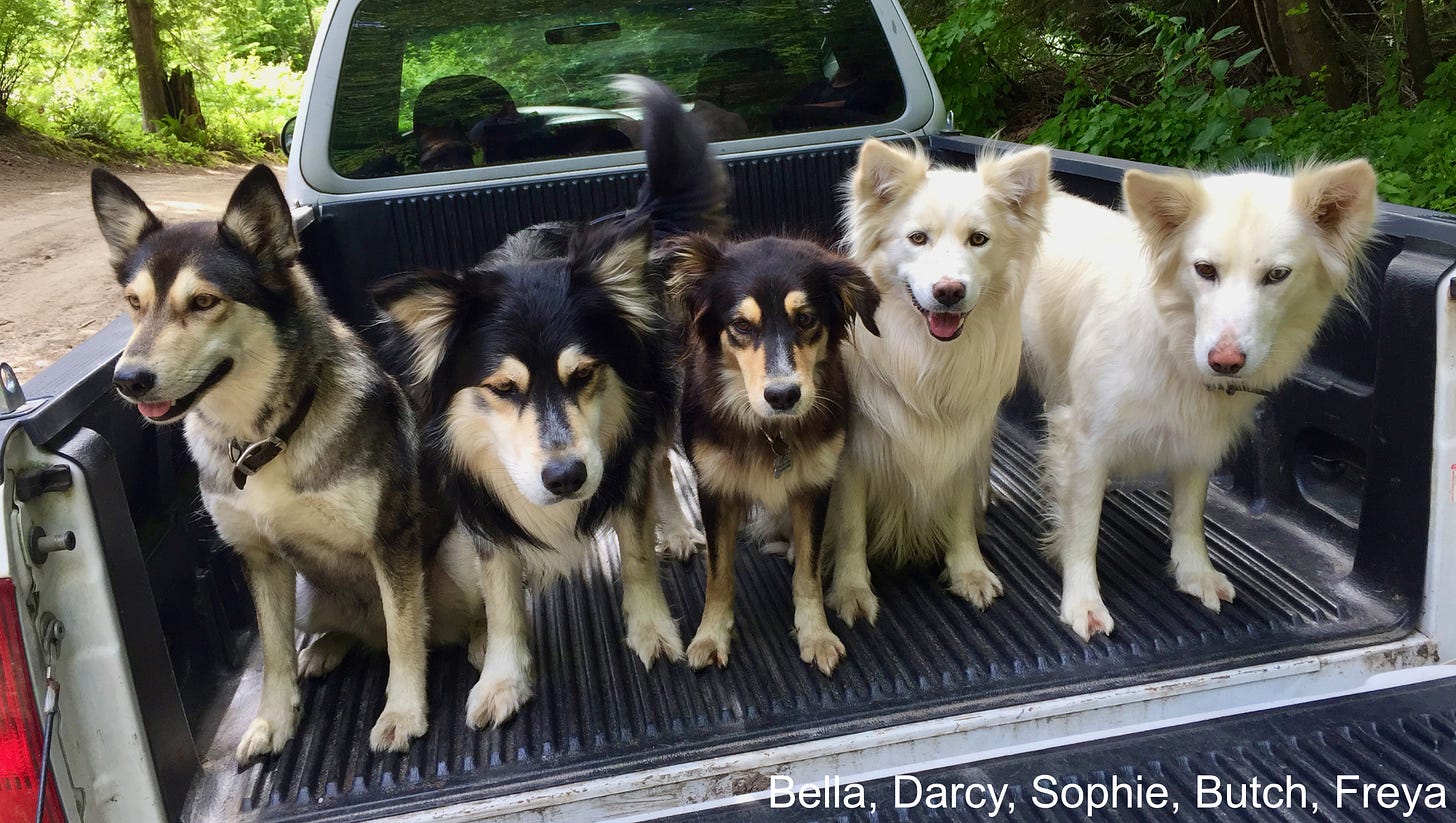
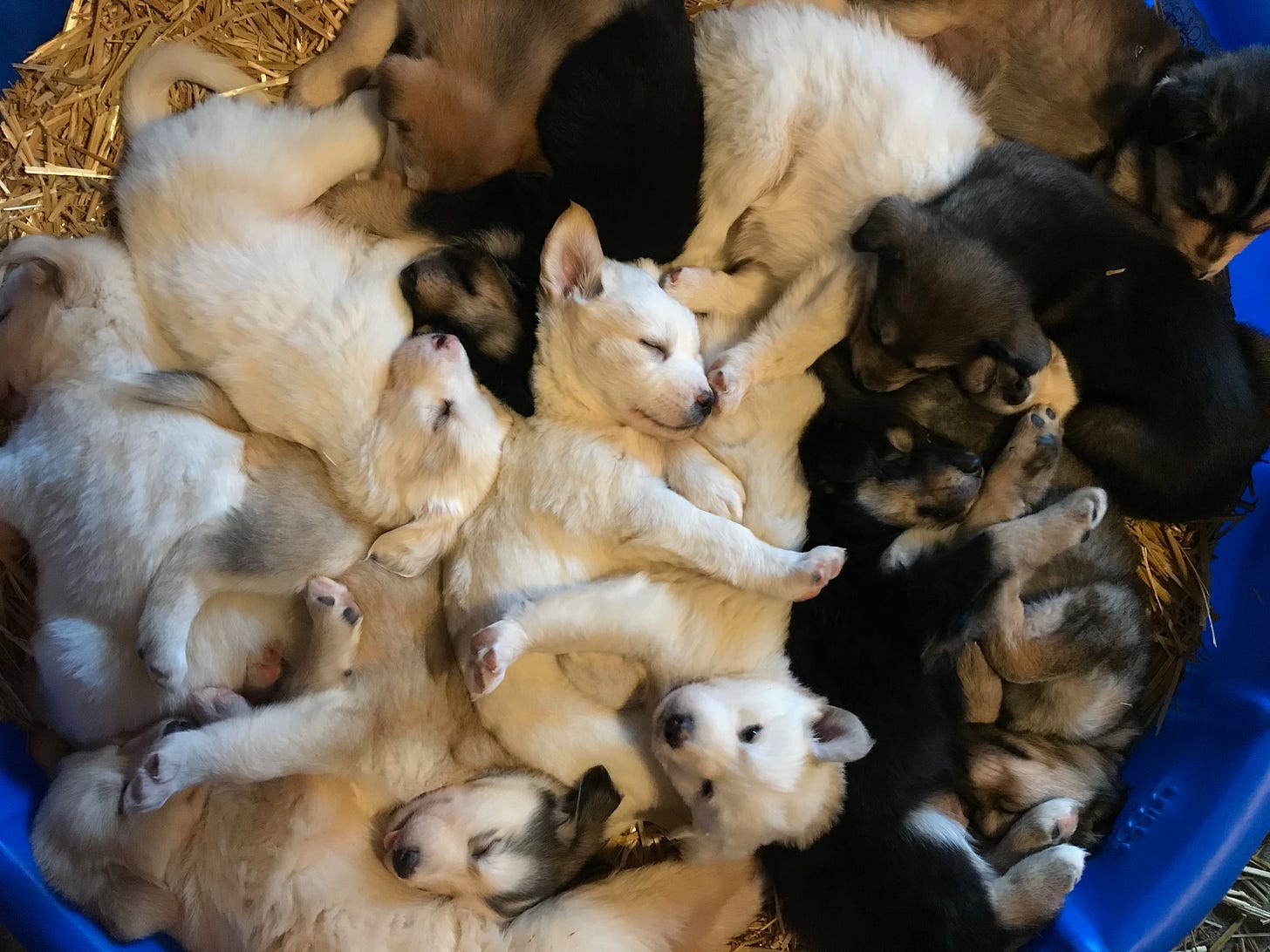
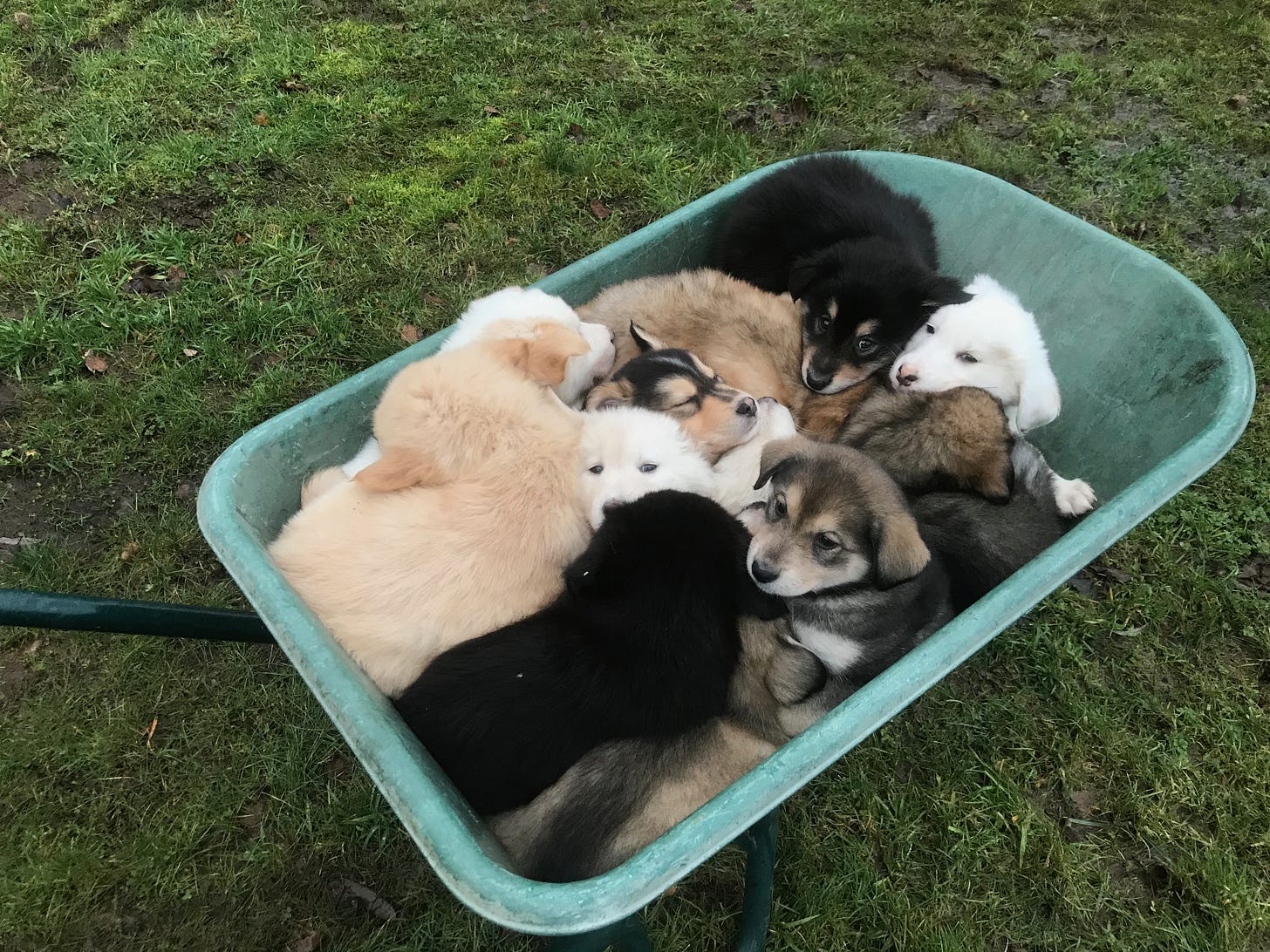

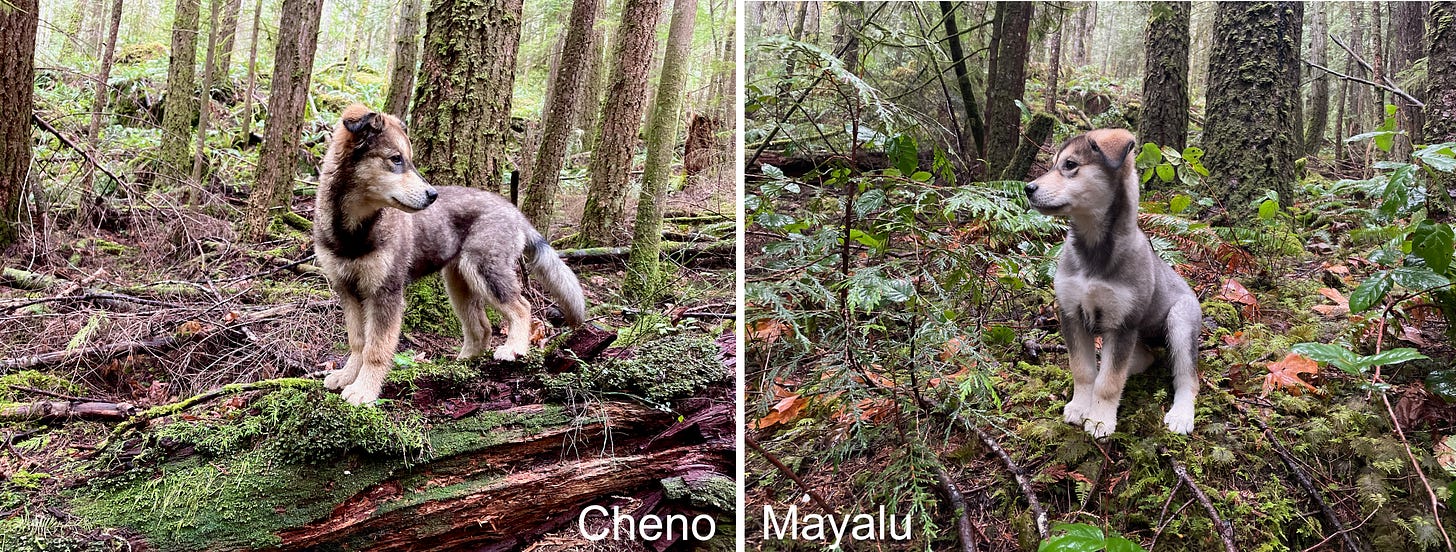
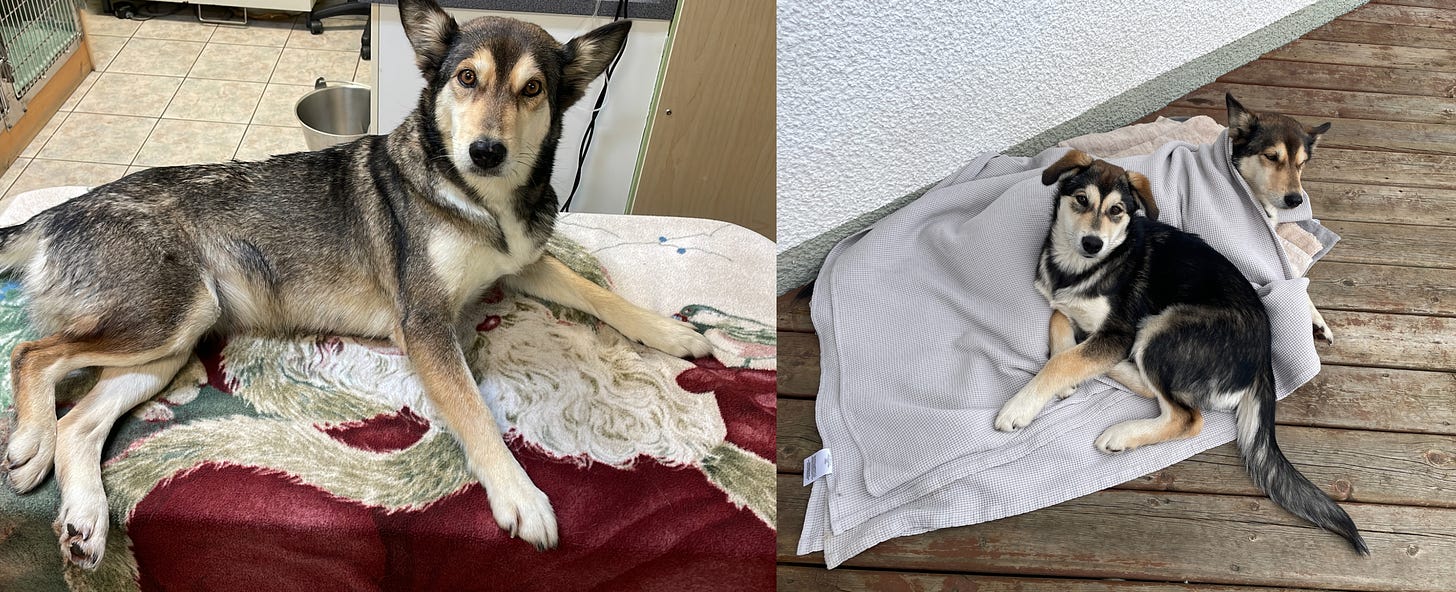
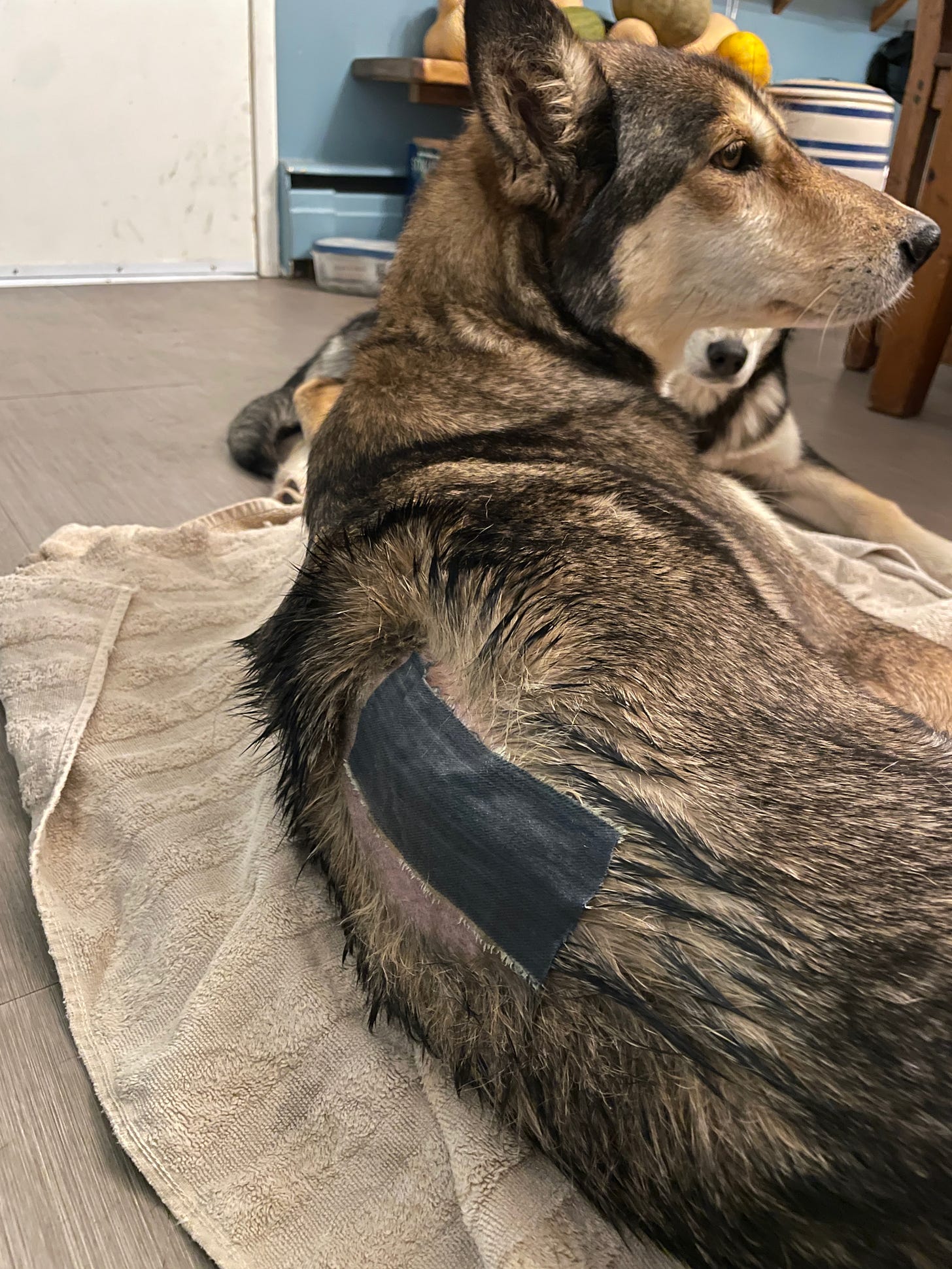
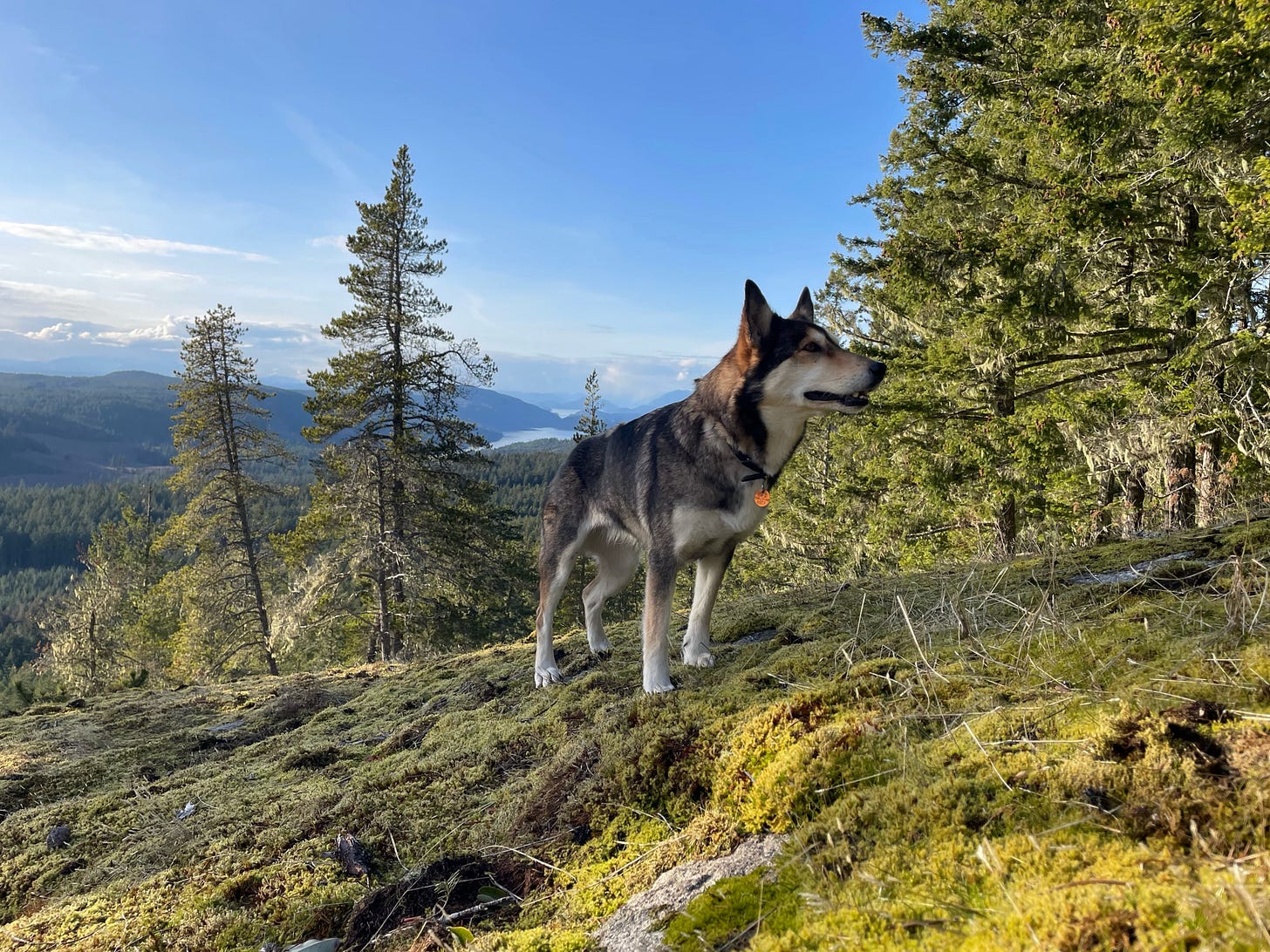
I was exploring herbs with my dog, and I had considered asking you this question about dog food so glad to find this article! Adding it to my read list.
Hi Todd, while I follow you as an herbalist, I had no idea you were such a devoted animal lover.Thank you for these dear heartfelt stories of your dogs and your interspecies healing.